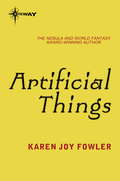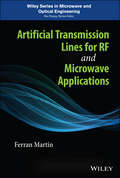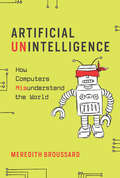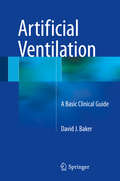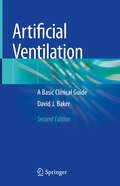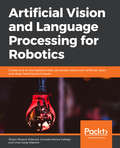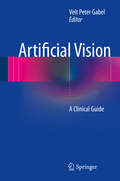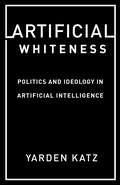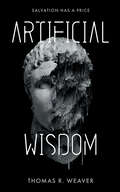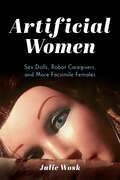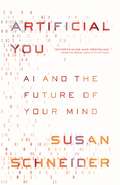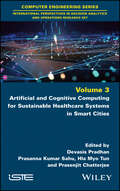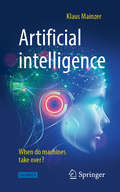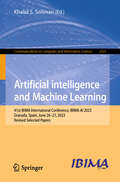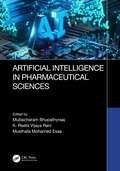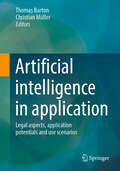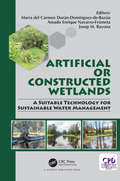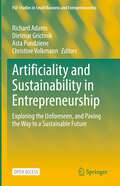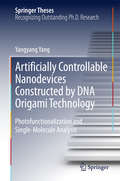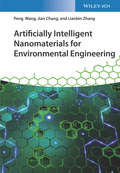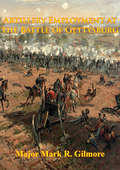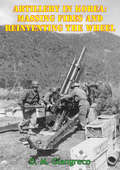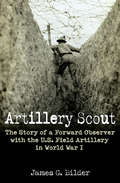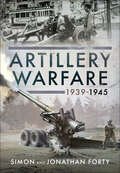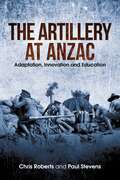- Table View
- List View
Artificial Things
by Karen Joy FowlerAn extraordinary collection of short stories from the award-winning author of Sarah Canary. Including "Praxis", the story about a theater where the real and unreal collide; "The Poplar Street Study", Fowler's darkly comic account of an alien invasion; and "The Gates of Ghosts", in which a child journeys to a strange and deadly world, this anthology of 13 tales also features a new foreword by the author.The lake was full of artificial things - The Poplar Street study - Face value - The dragon's head - The war of the roses - Contention - Recalling Cinderella - Other planes - The gate of ghosts - The bog people -Wild boys: variations on a theme - The view from Venus - Praxis
Artificial Transmission Lines for RF and Microwave Applications
by Ferran MartínThis book presents and discusses alternatives to ordinary transmission lines for the design and implementation of advanced RF/microwave components in planar technology.This book is devoted to the analysis, study and applications of artificial transmission lines mostly implemented by means of a host line conveniently modified (e.g., with modulation of transverse dimensions, with etched patterns in the metallic layers, etc.) or with reactive loading, in order to achieve novel device functionalities, superior performance, and/or reduced size. The author begins with an introductory chapter dedicated to the fundamentals of planar transmission lines. Chapter 2 is focused on artificial transmission lines based on periodic structures (including non-uniform transmission lines and reactively-loaded lines), and provides a comprehensive analysis of the coupled mode theory. Chapters 3 and 4 are dedicated to artificial transmission lines inspired by metamaterials, or based on metamaterial concepts. These chapters include the main practical implementations of such lines and their circuit models, and a wide overview of their RF/microwave applications (including passive and active circuits and antennas). Chapter 5 focuses on reconfigurable devices based on tunable artificial lines, and on non-linear transmission lines. The chapter also introduces several materials and components to achieve tuning, including diode varactors, RF-MEMS, ferroelectrics, and liquid crystals. Finally, Chapter 6 covers other advanced transmission lines and wave guiding structures, such as electroinductive-/magnetoinductive-wave lines, common-mode suppressed balanced lines, lattice-network artificial lines, and substrate integrated waveguides.Artificial Transmission Lines for RF and Microwave Applications provides an in-depth analysis and discussion of artificial transmission lines, including design guidelines that can be useful to researchers, engineers and students.
Artificial Unintelligence: How Computers Misunderstand the World (The\mit Press Ser.)
by Meredith BroussardA guide to understanding the inner workings and outer limits of technology and why we should never assume that computers always get it right.In Artificial Unintelligence, Meredith Broussard argues that our collective enthusiasm for applying computer technology to every aspect of life has resulted in a tremendous amount of poorly designed systems. We are so eager to do everything digitally—hiring, driving, paying bills, even choosing romantic partners—that we have stopped demanding that our technology actually work. Broussard, a software developer and journalist, reminds us that there are fundamental limits to what we can (and should) do with technology. With this book, she offers a guide to understanding the inner workings and outer limits of technology—and issues a warning that we should never assume that computers always get things right.Making a case against technochauvinism—the belief that technology is always the solution—Broussard argues that it's just not true that social problems would inevitably retreat before a digitally enabled Utopia. To prove her point, she undertakes a series of adventures in computer programming. She goes for an alarming ride in a driverless car, concluding “the cyborg future is not coming any time soon”; uses artificial intelligence to investigate why students can't pass standardized tests; deploys machine learning to predict which passengers survived the Titanic disaster; and attempts to repair the U.S. campaign finance system by building AI software. If we understand the limits of what we can do with technology, Broussard tells us, we can make better choices about what we should do with it to make the world better for everyone.
Artificial Ventilation: A Basic Clinical Guide
by David J. BakerThis bookprovides a basic clinical guide to the principles and practice of artificialventilation, both manual and mechanical. It covers the development ofartificial ventilation through the ages and the essential anatomy and physiologybehind it. While thereare many detailed texts available on mechanical ventilation, theyare usually aimed at the hospital specialist and cover the many complexmodes of ventilation used in the hospital setting. This book coversthe basics of airway and ventilation management for non-specialists working in pre-hospital andemergency medicine. It fulfils the need for a resource that explainssimply and clearly basic respiratory physiology, the pathophysiology behindrespiratory failure and the practical aspects of artificial ventilation. This book links the two areas of hospital and pre-hospital practice together topromote better understanding of artificial ventilation by medical, paramedicaland nursing personnel working in different fields of medicine.
Artificial Ventilation: A Basic Clinical Guide
by David J. BakerThis book provides a concise, clinical guide to the basics of airway and ventilation management for non-specialists working in pre-hospital and emergency medicine. It fulfills the need for a resource that simply and clearly explains the fundamentals of respiratory physiology, the pathophysiology behind respiratory failure and the practical aspects of artificial ventilation. Artificial Ventilation: A Basic Clinical Guide, 2nd edition has been expanded to include guidance on mass ventilation during a viral pandemic with lessons learnt from the COVID-19 outbreak. It has been fully revised to support non-specialist medical and nursing personnel to understand the basics of artificial ventilation and to be able to improvise mass ventilation outside the ICU. Professionals seeking a clear guidance on currently available devices and new approaches to mechanical ventilation will find this book to be an essential resource for all types of emergency situations where artificial ventilation is required.
Artificial Vision and Language Processing for Robotics: Create end-to-end systems that can power robots with artificial vision and deep learning techniques
by Álvaro Morena Alberola Gonzalo Molina Gallego Unai Garay MaestreCreate end-to-end systems that can power robots with artificial vision and deep learning techniquesKey FeaturesStudy ROS, the main development framework for robotics, in detailLearn all about convolutional neural networks, recurrent neural networks, and roboticsCreate a chatbot to interact with the robotBook DescriptionArtificial Vision and Language Processing for Robotics begins by discussing the theory behind robots. You'll compare different methods used to work with robots and explore computer vision, its algorithms, and limits. You'll then learn how to control the robot with natural language processing commands. You'll study Word2Vec and GloVe embedding techniques, non-numeric data, recurrent neural network (RNNs), and their advanced models. You'll create a simple Word2Vec model with Keras, as well as build a convolutional neural network (CNN) and improve it with data augmentation and transfer learning. You'll study the ROS and build a conversational agent to manage your robot. You'll also integrate your agent with the ROS and convert an image to text and text to speech. You'll learn to build an object recognition system using a video.By the end of this book, you'll have the skills you need to build a functional application that can integrate with a ROS to extract useful information about your environment.What you will learnExplore the ROS and build a basic robotic systemUnderstand the architecture of neural networksIdentify conversation intents with NLP techniquesLearn and use the embedding with Word2Vec and GloVeBuild a basic CNN and improve it using generative modelsUse deep learning to implement artificial intelligence(AI)and object recognitionDevelop a simple object recognition system using CNNsIntegrate AI with ROS to enable your robot to recognize objectsWho this book is forArtificial Vision and Language Processing for Robotics is for robotics engineers who want to learn how to integrate computer vision and deep learning techniques to create complete robotic systems. It will prove beneficial to you if you have working knowledge of Python and a background in deep learning. Knowledge of the ROS is a plus.
Artificial Vision: A Clinical Guide
by Veit Peter GabelThis book presents and analyses the most recent research dedicated to restoring vision in individuals who are severely impaired or blind from retinal disease or injury. It is written by the leading groups worldwide who are at the forefront of developing artificial vision. The book begins by discussing the difficulties in comparing and interpreting functional results in the area of very low vision and the principal prospects and limitations of spatial resolution with artificial tools. Further on, chapters are included by researchers who stimulate the surface or the pigment epithelial side of the retina and by experts who work on stimulating the optic nerve, the lateral geniculate body and the superficial layers of the visual cortex. Artificial Vision: A Clinical Guide collates the most recent work of key artificial vision research groups to explain in a comparable and stringent order their varying approaches, the clinical or preclinical outcomes and their achievements during the last years. Senior ophthalmic fellows and academic practitioners will find this guide to be an indispensable resource for understanding the current status of artificial vision.
Artificial Whiteness: Politics and Ideology in Artificial Intelligence
by Yarden KatzDramatic statements about the promise and peril of artificial intelligence for humanity abound, as an industry of experts claims that AI is poised to reshape nearly every sphere of life. Who profits from the idea that the age of AI has arrived? Why do ideas of AI’s transformative potential keep reappearing in social and political discourse, and how are they linked to broader political agendas?Yarden Katz reveals the ideology embedded in the concept of artificial intelligence, contending that it both serves and mimics the logic of white supremacy. He demonstrates that understandings of AI, as a field and a technology, have shifted dramatically over time based on the needs of its funders and the professional class that formed around it. From its origins in the Cold War military-industrial complex through its present-day Silicon Valley proselytizers and eager policy analysts, AI has never been simply a technical project enabled by larger data and better computing. Drawing on intimate familiarity with the field and its practices, Katz instead asks us to see how AI reinforces models of knowledge that assume white male superiority and an imperialist worldview. Only by seeing the connection between artificial intelligence and whiteness can we prioritize alternatives to the conception of AI as an all-encompassing technological force.Bringing together theories of whiteness and race in the humanities and social sciences with a deep understanding of the history and practice of science and computing, Artificial Whiteness is an incisive, urgent critique of the uses of AI as a political tool to uphold social hierarchies.
Artificial Wisdom
by Thomas R. WeaverIn this propulsive near-future thriller, a journalist uncovers a plot that will upend the order of our world, involving a mysterious murder, a global political battle between a human politician and an AI, and the fight for survival in a climate-ravaged landscape.In 2050, investigative journalist Marcus Tully is still grieving the loss of his wife and unborn child in the deadly heatwave that struck the Persian Gulf ten years ago.Now, the world is both burning and drowning, and the decision has been taken to elect a global leader to steer humanity through the worsening climate apocalypse. The final two candidates are ex-US president Lockwood, and Solomon, an Artificial Intelligence.As election day races closer, Tully begins to unravel a conspiracy that goes to the highest level. Then Solomon&’s creator is murdered, and Tully is pulled in to find the culprit.As the two investigations intertwine in ways he could never have imagined and the world hurtles ever closer to the brink, Tully must find the truth, convince the world to face it and make impossible choices to secure the future of the species.But will humanity ultimately choose salvation over freedom, whatever the cost?
Artificial Women: Sex Dolls, Robot Caregivers, and More Facsimile Females
by Julie WoskWhat distinguishes humanity from artificial beings? What do constructed creatures tell us about ourselves? From sex dolls to Siri, talking Barbies to robotic mothers, Artificial Women explores the ways in which today's simulated females—both real and fictional—reflect and expose our own ideas about gender and female identity. Join Julie Wosk as she probes the realm of compliant sex workers, nurturing caretakers, genial servants, and rebellious creations in film, television, literature, art, photography, and current developments in robotics. These modern-day Galateas must embrace their own synthetic nature while also striving for authenticity and autonomy, all the while foregrounding gender stereotypes and changing perceptions of women and their roles. They embody the paradoxes and tensions that continue to arise in our increasingly simulated world, where the lines between the real and the virtual only continue to blur. As these "artificial women" become ever more lifelike, so too do the questions they raise become more provocative, and more illuminating of our own conceptions and conventions. Artificial Women pushes the boundaries of gender, sexuality, and culture studies to consider new digital technologies, artificial intelligences, and burgeoning simulations.
Artificial You: AI and the Future of Your Mind
by Susan SchneiderA sober-minded philosophical exploration of what AI can and cannot achieveHumans may not be Earth’s most intelligent beings for much longer: the world champions of chess, Go, and Jeopardy! are now all AIs. Given the rapid pace of progress in AI, many predict that it could advance to human-level intelligence within the next several decades. From there, it could quickly outpace human intelligence. What do these developments mean for the future of the mind?In Artificial You, Susan Schneider says that it is inevitable that AI will take intelligence in new directions, but urges that it is up to us to carve out a sensible path forward. As AI technology turns inward, reshaping the brain, as well as outward, potentially creating machine minds, it is crucial to beware. Homo sapiens, as mind designers, will be playing with "tools" they do not understand how to use: the self, the mind, and consciousness. Schneider argues that an insufficient grasp of the nature of these entities could undermine the use of AI and brain enhancement technology, bringing about the demise or suffering of conscious beings. To flourish, we must grasp the philosophical issues lying beneath the algorithms.At the heart of her exploration is a sober-minded discussion of what AI can truly achieve: Can robots really be conscious? Can we merge with AI, as tech leaders like Elon Musk and Ray Kurzweil suggest? Is the mind just a program? Examining these thorny issues, Schneider proposes ways we can test for machine consciousness, questions whether consciousness is an unavoidable byproduct of sophisticated intelligence, and considers the overall dangers of creating machine minds.
Artificial and Cognitive Computing for Sustainable Healthcare Systems in Smart Cities
by Prasenjit Chatterjee Devasis Pradhan Prasanna Kumar Sahu Hla Myo TunArtificial and Cognitive Computing for Sustainable Healthcare Systems in Smart Cities delves into the transformative potential of artificial and cognitive computing in the realm of healthcare systems, maintaining a specific emphasis on sustainability. By exploring the integration of advanced technologies in smart cities, the authors examine and discuss how AI and cognitive computing can be harnessed to enhance healthcare delivery. The book provides focused navigation through innovative solutions and strategies that contribute to the creation of sustainable healthcare ecosystems within the dynamic environment of smart cities. From optimizing resource utilization to improving patient outcomes, this comprehensive exploration provides insight for readers with an interest in the future of healthcare within the era of intelligent urban development.
Artificial intelligence - When do machines take over? (Technik im Fokus)
by Klaus MainzerEverybody knows them. Smartphones that talk to us, wristwatches that record our health data, workflows that organize themselves automatically, cars, airplanes and drones that control themselves, traffic and energy systems with autonomous logistics or robots that explore distant planets are technical examples of a networked world of intelligent systems. Machine learning is dramatically changing our civilization. We rely more and more on efficient algorithms, because otherwise we will not be able to cope with the complexity of our civilizing infrastructure. But how secure are AI algorithms? This challenge is taken up in the 2nd edition: Complex neural networks are fed and trained with huge amounts of data (big data). The number of necessary parameters explodes exponentially. Nobody knows exactly what is going on in these "black boxes". In machine learning we need more explainability and accountability of causes and effects in order to be able to decide ethical and legal questions of responsibility (e.g. in autonomous driving or medicine)! Besides causal learning, we also analyze procedures of tests and verification to get certified AI-programs. Since its inception, AI research has been associated with great visions of the future of mankind. It is already a key technology that will decide the global competition of social systems. "Artificial Intelligence and Responsibility" is another central supplement to the 2nd edition: How should we secure our individual liberty rights in the AI world? This book is a plea for technology design: AI must prove itself as a service in society.
Artificial intelligence and Machine Learning: 41st IBIMA International Conference, IBIMA-AI 2023, Granada, Spain, June 26–27, 2023, Revised Selected Papers (Communications in Computer and Information Science #2101)
by Khalid S. SolimanThis book constitutes the revised selected papers of the 41st IBIMA International Conference on Artificial intelligence and Computer Science, IBIMA-AI 2023, which took place in Granada, Spain during June 26-27, 2023. The 30 full papers and 8 short papers included in this volume were carefully reviewed and selected from 58 submissions. The book showcases a diverse array of research papers spanning various disciplines within the realm of Artificial Intelligence, Machine Learning, Information Systems, Communications Technologies, Software Engineering, and Security and Privacy.
Artificial intelligence in Pharmaceutical Sciences
by Musthafa Mohamed Essa Mullaicharam Bhupathyraaj Reeta Vijaya Rani, K.This cutting-edge reference book discusses the intervention of artificial intelligence in the fields of drug development, modified drug delivery systems, pharmaceutical technology, and medical devices development. This comprehensive book includes an overview of artificial intelligence in pharmaceutical sciences and applications in the drug discovery and development process. It discusses the role of machine learning in the automated detection and sorting of pharmaceutical formulations. It covers nanosafety and the role of artificial intelligence in predicting potential adverse biological effects. FEATURES Includes lucid, step-by-step instructions to apply artificial intelligence and machine learning in pharmaceutical sciences Explores the application of artificial intelligence in nanosafety and prediction of potential hazards Covers application of artificial intelligence in drug discovery and drug development Reviews the role of artificial intelligence in assessment of pharmaceutical formulations Provides artificial intelligence solutions for experts in the pharmaceutical and medical devices industries This book is meant for academicians, students, and industry experts in pharmaceutical sciences, medicine, and pharmacology.
Artificial intelligence in application: Legal aspects, application potentials and use scenarios
by Thomas Barton Christian MüllerThe book shows application potentials of artificial intelligence in various industries and presents application scenarios on how a practical implementation can take place. The starting point is the description of legal aspects, which includes a European regulation for artificial intelligence and addresses the question of the permissibility of automated decisions. The description of various application potentials, mostly industry-related, and the presentation of some application scenarios form the focus of the topic volume. The book is based on the question of how artificial intelligence can be used in entrepreneurial practice. It offers important information that is just as relevant for practitioners as for students and teachers. This book is a translation of an original German edition. The translation was done with the help of artificial intelligence (machine translation by the service DeepL.com). A subsequent human revision was done primarily in terms of content, so that the book will read stylistically differently from a conventional translation.
Artificial or Constructed Wetlands: A Suitable Technology for Sustainable Water Management
by María del Durán-Domínguez-de-Bazúa Amado Enrique Navarro-Frómeta Josep M. BayonaArtificial or constructed wetlands are an emerging technology particularly for tropical areas with water scarcity. For big cities, the sustainable management of water resources taking into account proper use is always challenging. The book presents case studies illustrating the above. As plants and microorganisms are a fundamental part of the correct functioning of these systems, their contribution to the degradation of the organic matter and to the removal and transformation of the pollutant compounds present in the wastewaters is also a highlight of this book.
Artificiality and Sustainability in Entrepreneurship: Exploring the Unforeseen, and Paving the Way to a Sustainable Future (FGF Studies in Small Business and Entrepreneurship)
by Richard Adams Dietmar Grichnik Asta Pundziene Christine VolkmannThis open access edited volume explores the past, present, and future of artificiality and sustainability in entrepreneurship – the unforeseen consequences and ways to advance to a sustainable future. In particular, it connects artificiality, sustainability and entrepreneurship, intertwining artificial with the specific phenomenon of those novel digital technologies that provoke continuous and significant change in our lives and business. Unlike digital entrepreneurship research, which focuses on digital technology development and management, this book covers processes and mechanisms of sustainable adaptability of entrepreneurs, the business logic of start-ups, and the collaborative behaviours under the mass digital transformation, including the prevalence of artificial intelligence. Some of the questions that this book answers are as follows: How has entrepreneurship reacted to such challenges previously? What lessons have been learned and need to be carried forward? How can entrepreneurship and the artefacts of entrepreneurship respond to current challenges? What should be the mindset of the entrepreneur to assure sustainable adaptation? How to embrace and embed the new business logic?
Artificially Controllable Nanodevices Constructed by DNA Origami Technology: Photofunctionalization and Single-Molecule Analysis (Springer Theses)
by Yangyang YangIn this book, the author deals mainly with two topics: (1) single-molecule visualization of switching behaviors in the DNA nanoframe system utilizing different kinds of molecular switches through the use of high-speed atomic force microscope (AFM); (2) construction of photocontrollable DNA nanostructures in programmed patterns and direct visualization of the dynamic assembling process. Here, high-speed AFM was employed to observe the dynamic movements of single molecules. Compared to a traditional single-molecule analysis method, such as fluorescence spectroscopy or electron microscopy, high-speed AFM makes possible the real-time observation of molecule behaviors. DNA nanostructures were designed and assembled as scaffolds to incorporate interested biomolecules. The observations were carried out under robust conditions without complicated pretreatment. Moreover, the photoresponsive molecules were successfully assembled into around 100 nm-sized DNA nanostructures. The assembly/disassembly of nanostructures can be regulated reversibly by photoirradiation. This book explains how DNA origami has gradually become a useful tool for the investigation of biochemical interactions in defined nanospace. It also shows the possibility of DNA nanostructures acting as nanodevices for application in biological systems, serving as a good introduction to basic DNA nanotechnology.
Artificially Intelligent Nanomaterials for Environmental Engineering: For Environmental Engineering
by Peng Wang Jian Chang Lianbin ZhangPresents novel, nanotechnology-based solutions for urgent environmental engineering problems Clear and concise from beginning to end, this book focuses on the design and application of artificially intelligent nanomaterials, which help in solving many tangible environmental problems?especially water and air pollution. It lays out the design concepts, major chemical principles, and materials considerations of artificially intelligent nanomaterials for environmental engineering, and provides proof-of-concept examples such as improved filtration membranes, nanofibrous air filters, and molecularly imprinted nanomaterials. Artificially Intelligent Nanomaterials: For Environmental Engineering starts by describing the background of environmental nanotechnology, the rise of Artificial Intelligence (AI), and the current status of AI in environmental engineering. It then looks at: intelligently functional materials and responsive mechanisms; designing filtration membranes with responsive gates; switchable wettability materials for controllable oil/water separation; and self-healing materials for environmental applications. The book continues with chapters that examine: emerging nanofibrous air filters for PM2.5 removal; self-propelled nanomotors for environmental applications; molecular imprinting in wastewater treatment; and emerging synergistically multifunctional and all-in-one nanomaterials and nanodevices in advanced environmental applications. -Presents the state-of-the-art in environmental technology and puts forward bold ideas for its advancement -Addresses global challenges, including all important water and air quality which are critical for human health and a sustainable future -Concentrates on nanotechnology-enabled solutions for pollutant removal from water and air Artificially Intelligent Nanomaterials: For Environmental Engineering is an ideal book for undergraduates, graduates, scientists, and professionals in the fields of environmental science, material science, chemistry, and chemistry engineering.
Artillery Employment At The Battle Of Gettysburg [Illustrated Edition]
by Major Mark R. GilmoreIncludes Civil War Map and Illustrations Pack - 224 battle plans, campaign maps and detailed analyses of actions spanning the entire period of hostilities.This book is an historical analysis of the Union artillery at the Battle of Gettysburg. It examines the significance of the Union artillery's contribution to the Federal victory. This study explores all aspects of the tactical employment of the Union artillery on the first and last days of the battle. A brief description of the evolution of artillery organization in the Army of the Potomac prior to the battle of Gettysburg is included. This is followed by the chronological presentation of the tactical employment of artillery during the battle. First its employment in the meeting engagement on 1 July is examined, followed by a study of its use on the final and decisive third day when Union forces fought a set-piece defensive battle. Among the conclusions arrived at during the course of this study are these: that the Army of the Potomac's corps artillery brigades and army artillery reserve proved to be responsive and efficient organizations in fulfilling their fire support mission, and when coupled with the skillful use of artillery and aggressive leadership by the army's Chief-of-Artillery, Brigadier-General Hunt, were crucial to the successful employment of the Union artillery forces. This study concludes that the Union artillery under the command of Brigadier General Henry Hunt had a decided and positive influence on the Federal victory by successfully employing its corps artillery brigades and army artillery reserve as part of a combined arms force.
Artillery In Korea: Massing Fires And Reinventing The Wheel [Illustrated Edition]
by D. M. Giangreco[Includes 10 photos illustrations]The first 9 months of the Korean War saw U.S. Army field artillery units destroy or abandon their own guns on nearly a dozen occasions. North Korean and Chinese forces infiltrated thinly held American lines to ambush units on the move or assault battery positions from the flanks or rear with, all too often, the same disastrous results. Trained to fight a linear war in Europe against conventional Soviet forces, field artillery units were unprepared for combat in Korea, which called for all-around defense of mutually supporting battery positions, and high-angle fire. Ironically, these same lessons had been learned the hard way during recent fighting against the Japanese in a 1944 action on Saipan, not Korea, aptly demonstrates. Pacific theater artillery tactics were discarded as an aberration after War World II, but Red Legs soon found that they "frequently [have] to fight as doughboys" and "must be able to handle the situation themselves if their gun positions are attacked." A second problem with artillery in Korea was felt most keenly by the soldiers that the artillery was supposed to support -- the infantry. Commanders at all levels had come to expect that in any future war, they would conduct operations with fire that equaled or even surpassed the lavish support they had recently enjoyed in northwest Europe. It was clear almost from the beginning, however, that this was not going to happen in Korea because there was a shortage not only of artillery units but also of the basic hardware of the cannoneers craft: guns and munitions. Until the front settled down into a war of attrition in the fall of 1951 (which facilitated the surveying of reference points and positioning of "an elaborate grid of batteries, fire direction centers, [and] fire support coordination centers"), massed fires were achieved by shooting at unprecedented speed.
Artillery Scout: The Story of a Forward Observer with the U.S. Field Artillery in World War I
by James G. Bilder“Moves quickly; it entertains and provides a decent overview of the life of an American Doughboy” on the Western Front during the Great War (San Francisco Book Review).The American Doughboys of World War I are often referred to as the “Lost Generation”; however, in this book, we are able to gain an intimate look at their experiences after being thrust into the center of Europe’s “Great War” and enduring some of the most grueling battles in US history.Len Fairfield, the author’s grandfather, was an Artillery Scout, or Forward Observer, for the US Army and was a firsthand witness to the war’s carnage as he endured its countless hardships, all of which are revealed here in vivid detail. His story takes the reader from a hard life in Chicago, through conscription, rigorous training in America and France, and finally to the battles which have become synonymous with the US effort in France—St. Mihiel and the Argonne Forest, the latter claiming 26,000 American lives, more than any other US battle.The American Expeditionary Forces endured a rare close-quarters visit to hell until it was sensed that the Germans were finally giving way, though fighting tooth-and-nail up to the very minute of the Armistice. This action-filled work brings the reader straight to the center of America’s costly battles in World War I, reminding us once again how great-power status often has to be earned with blood on battlefields.“All in all, this book is a bit of a gem. It is a well paced easy read and you will find yourself rooting for our hero.” —War in History
Artillery Warfare, 1939–1945
by Simon Forty Jonathan Forty“From mountain warfare with guns on mules to V2 rockets and everything between makes it well worth a place on anyone’s reference shelf.” —Clash of SteelIt is said that artillery won the Second World War for the Allies—that Soviet guns wore down German forces on the Eastern Front, negating their superior tactics and fighting ability, and that the accuracy and intensity of the British and American artillery was a major reason for the success of Allied forces in North Africa from El Alamein, in Italy and Normandy, and played a vital role in the battles of 1944 and 1945. Yet the range of weapons used is often overlooked or taken for granted—which is why this highly illustrated history by Simon and Jonathan Forty is of such value. They stress the importance of artillery on every front and analyze how artillery equipment, training and tactical techniques developed during the conflict.The selection of wartime photographs—many from east European sources—and the extensive quotations from contemporary documents give a graphic impression of how the guns were used on all sides. The photographs emphasize the wide range of pieces employed as field, antiaircraft and antitank artillery without forgetting self-propelled guns, coastal and other heavyweights and the development of rockets. The authors offer a fascinating insight into the weapons that served in the artillery over seventy years ago.“Superbly illustrated, this is testament to the courage and skills of extraordinary men in the execution of their duty. An amazing book.” —Books Monthly
Artillery at Anzac: Adaptation, Innovation and Education
by Chris Roberts Paul StevensA Simon & Schuster eBook. Simon & Schuster has a great book for every reader.
